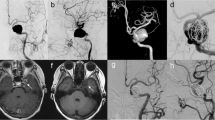Abstract
Objectives
To characterise the safety, efficacy and cost of direct carotid-cavernous fistula (CCF) treatment using polyvinyl alcohol copolymer or detachable balloons.
Methods
We reviewed retrospectively patients with direct CCFs treated with either a detachable balloon or polyvinyl alcohol copolymer at our hospital from 2005 to 2015 and identified 94 patients with 105 CCFs. All patients had follow-up angiograms. The CCF occlusion rate, procedure complication rate, treatment expense and operation time were recorded.
Results
With a mean of 5.4 months of angiographic follow-up, the complete occlusion rate and recanalisation rate of the polyvinyl alcohol copolymer group was not significantly different from that of the detachable balloon group. The treatment expense was much higher and the operation time was much longer in the polyvinyl alcohol copolymer group than the detachable balloon group (P < 0.001).
Conclusions
Embolisation of CCF with polyvinyl alcohol copolymer is as safe and effective as detachable balloon but has a much higher cost and longer operation time.
Key Points
• Carotid-cavernous fistula results from a damaged carotid artery.
• Detachable balloons have been used with success for many years.
• Some reported excellent outcomes after embolisation with polyvinyl alcohol copolymer.
• Treatment expense is much higher in the polyvinyl alcohol copolymer group.



Similar content being viewed by others
References
Marques MC, Caldas JG, Nalli DR et al (2010) Follow-up of endovascular treatment of direct carotid-cavernous fistulas. Neuroradiology 52:1127–1133
Chi CT, Nguyen D, Duc VT et al (2014) Direct traumatic carotid cavernous fistula: angiographic classification and treatment strategies study of 172 cases. Interv Neuroradiol 20:461–475
Gupta AK, Purkayastha S, Krishnamoorthy T et al (2006) Endovascular treatment of direct carotid cavernous fistulae: a pictorial review. Neuroradiology 48:831–839
Niu Y, Li L, Tang J et al (2016) Embolization of direct carotid cavernous fistulas with the novel double-balloon technique. Interv Neuroradiol 22:201–205
Zenteno M, Santos-Franco J, Rodriguez-Parra V et al (2010) Management of direct carotid-cavernous sinus fistulas with the use of ethylene-vinyl alcohol (Onyx) only: preliminary results. J Neurosurg 112:595–602
Baccin CE, Campos CMS, Abicalaf R et al (2005) Traumatic carotid-cavernous fistula: endovascular treatment with onyx and coils. Interv Neuroradiol 11:363–367
Ramalingaiah AH, Prasad C, Sabharwal PS et al (2013) Transarterial treatment of direct carotico-cavernous fistulas with coils and Onyx. Neuroradiology 55:1213–1220
Li ZQ, Liang GB, Zhang HF et al (2011) Endovascular embolization of traumatic carotid cavernous fistula by arterial approach: clinical analysis of 142 cases. J Trauma Surg 13:123–125
Liu SK, Liu YZ, Ni CF et al (2015) Efficacy of transarterial embolization for carotid-cavernous fistulas. Chin J Interv Imaging Ther 12:653–656
Zhang QR, Fang JM, Wu Q et al (2014) Transarterial embolization of traumatic carotid cavernous fistula with balloon: clinical analysis of 48 cases. Chin J Minim Invasive Neurosurg 20:217–218
Wang W, Li YD, Li MH et al (2001) Endovascular treatment of post-traumatic direct carotid-cavernous fistulas: a single-center experience. J Clin Neurosci 18:24–28
Zhao YY, Zhou XB, Zou AQ et al (2012) The clinical research of carotid-cavernous fistula endovascular treatment with detachable balloons. J Nanchang Univ (Med Sci) 52:70–72
Hassan T, Rashad S, Aziz W et al (2015) Endovascular modalities for the treatment of cavernous sinus arteriovenous fistulas: a single-center experience. J Stroke Cerebrovasc Dis 24:2824–2838
Barber SM, Rangel-Castilla L, Zhang YJ et al (2015) Mid- and long-term outcomes of carotid-cavernous fistula endovascular management with Onyx and n-BCA: experience of a single tertiary center. J Neurointerv Surg 7:762–769
Elhammady MS, Wolfe SQ, Farhat H, Moftakhar R, Aziz-Sultan MA (2010) Onyx embolization of carotid-cavernous fistulas. J Neurosurg 112:589–594
Briganti F, Tortora F, Marseglia M, Napoli M, Cirillo L (2009) Covered stent implantation for the treatment of direct carotid-cavernous fistula and its mid-term follow-up. Interv Neuroradiol 15:185–190
Li K, Dho YD, Kim KM, Kang HS, Kim JE, Hand MH (2014) Covered stents for the endovascular treatment of a direct carotid cavernous fistula: single center experiences with 10 cases. J Korean Neurosurg Soc 57:12–18
Acknowledgments
We would like to acknowledge further polishing to improve the literary beauty of the language and the rationality of the content received from Dr. Lei Feng (Kaiser Permanente Los Angeles Medical Center, Los Angeles, CA, USA), and the helpful comments on this article received from the reviewers.
Author information
Authors and Affiliations
Corresponding author
Ethics declarations
Guarantor
The scientific guarantor of this publication is Chuanzhi Duan.
Conflict of interest
The authors of this manuscript declare no relationships with any companies, whose products or services may be related to the subject matter of the article.
Funding
This study has received funding by National Natural Science Foundation of China (81400943) and Medical Scientific Research Foundation of Guangdong Province, China (QD2013NO11).
Statistics and biometry
Zhenjun Li and Lingfeng Lai kindly provided statistical advice for this manuscript.
Informed consent
The consent about the procedure and embolical material was signed by each patient.
Ethical approval
Our institution does not require IRB approval for this type of retrospective and written informed consents were obtained from all patients before the endovascular treatment. This study was performed under the supervision of the Institutional Review Board of Zhujiang Hospital of Southern Medical University.
Methodology
Retrospective, observational study; performed at one institution.
Rights and permissions
About this article
Cite this article
He, X., Duan, C., Lai, L. et al. Comparison of polyvinyl alcohol copolymer with detachable balloons for the embolisation of direct carotid cavernous fistula: a single-centre experience. Eur Radiol 27, 4730–4736 (2017). https://doi.org/10.1007/s00330-017-4864-2
Received:
Revised:
Accepted:
Published:
Issue Date:
DOI: https://doi.org/10.1007/s00330-017-4864-2




